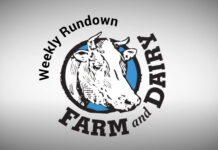The future of your herd starts with calf care. While the focus is usually on colostrum management, milk feeding programs and hygiene of your milk feeding equipment, your starter and water management are also critical to maximizing calf performance.
Water is vital
Water makes up approximately 75% of a calf’s body weight, making it a vital daily nutrient essential for various biological functions, including metabolism. Increased water and starter intake during the first 2 months of age are positively correlated with milk yield during the first lactation.
As a calf grows, its need for water also increases. A 1-month-old calf needs 1.3-2 gallons of water per day; at 2 months of age, this increases to 1.5-2.4 gallons per day, while a 3-month-old weaned calf needs 2.1-2.8 gallons per day.
As the rumen develops, microorganisms require water for fermentation. Water dilutes the volatile fatty acids (VFAs) produced by the rumen, allowing the rumen bacteria to generate more VFAs, providing nutrients to the animal. This supports rumen papillae growth. When water isn’t present, these microbes do not thrive and fewer VFAs are produced.
While milk contains water, this water does not boost calf starter consumption and rumen development. Milk water should not normally enter the rumen. It does not contribute to creating an environment conducive to rumen development.
A strong correlation exists between dry matter intake and water intake. Calves need four times the amount of water to the amount of dry matter they are consuming. When a calf consumes 1 pound of starter feed per day, it requires at least a half-gallon of water per day.
In the winter, warm water encourages consumption, but even in the summer, there may be benefits to providing warm water. When a calf drinks water at 45 degrees F, there is a rapid drop in rumen temperature that takes approximately one hour to return to normal, requiring energy to restore the rumen temperature to its normal level.
How it’s served
While water is often provided in a bucket, during times of low humidity, especially in the winter, providing water in a bottle can encourage consumption and improve calf health. As calves breathe, they expel water. In low humidity and cold temperatures, if the calf is not consuming water, especially if it is scouring, it can become dehydrated even faster than under normal weather conditions.
Research shows that changing water daily increases water consumption, along with scrubbing and rinsing the buckets at least weekly with a weak bleach solution of 1/4 cup of bleach in 1.25 gallons of water. When water is contaminated with feed, manure or algae growth in the bucket, water consumption declines.
Physical qualities
While water is critical for starter consumption, the physical quality of the starter can significantly impact its consumption. It takes approximately 21 days of starter consumption before weaning to allow for enough rumen development.
To minimize the weaning slump, a calf should consume at least half a pound of starter per day for four weeks before weaning, then increase consumption to one pound per day for two weeks and continue this increase consumption to at least two pounds per day for three days before weaning.
Calf starter consumption discussions often revolve around pelleted or texturized starter; however, the real discussion should be about the amount of fines that either of these contains.
One study used the exact same ration, except one version contained fines and the other was course-textured with few small particles. This study found an 11% reduction in calf starter intake when fines were present. Even in a texturized starter, the minerals and vitamins are often in a pelleted form. If the pellet is too soft, it will break apart over time, resulting in an increase in fines and a decrease in consumption.
Another major factor in starter consumption is how the starter is presented to the calf. A calf will consume starter sooner from a shallow bowl that it can reach to the bottom of and still see out of. While calves prefer fresh starter changed daily, checking it daily for wet feed and changing it twice per week helps to keep it fresh. Only feeding a small amount that the calf will eat in a couple of days also helps to keep the feed fresh and decrease dumped refusals.
While the ingredients in a starter can significantly impact rumen development and calf growth, the physical characteristics, presentation and water availability play a crucial role in determining the amount of starter consumed.













